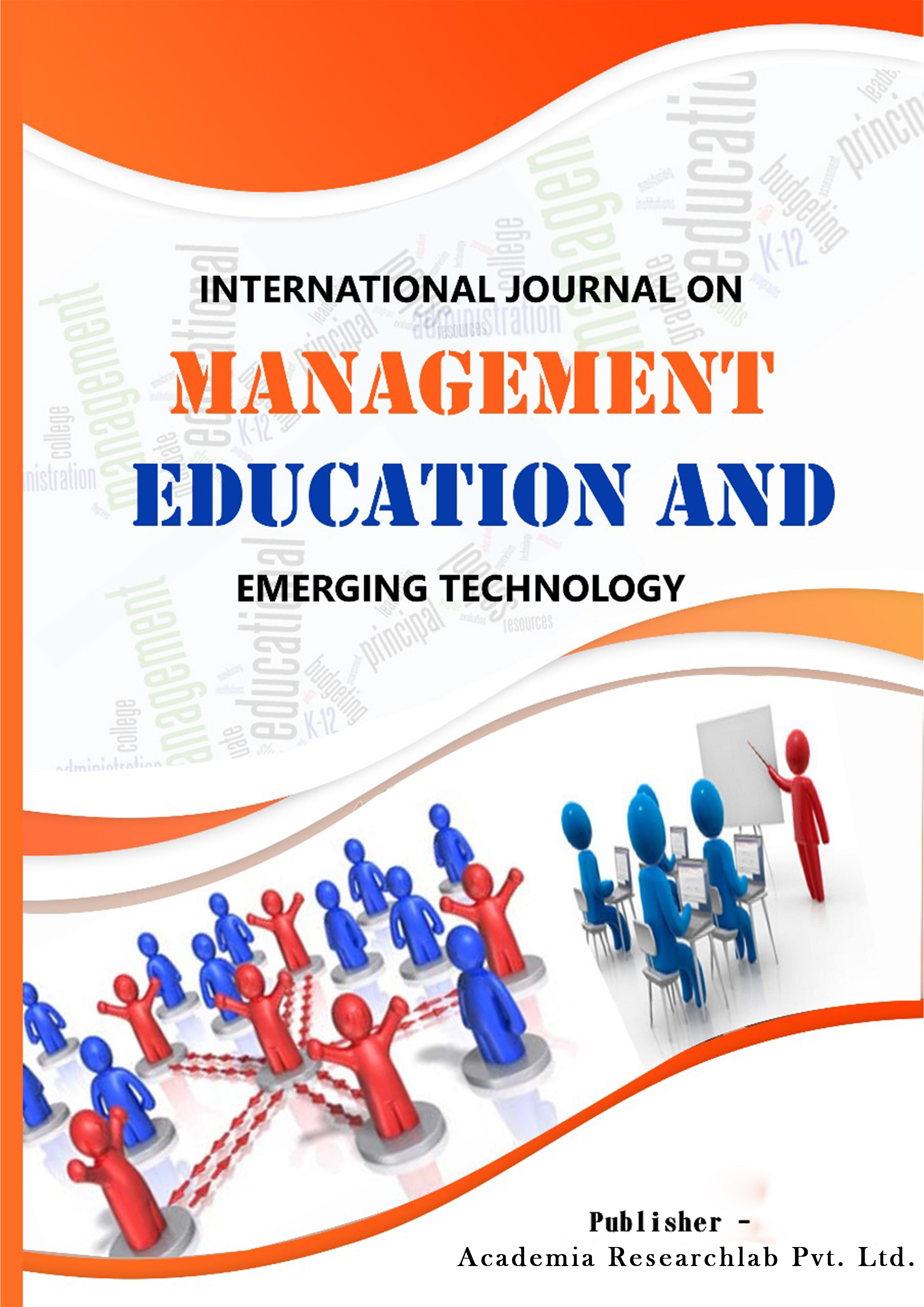Unveiling Multifaceted Emotions In Music Video: Understanding Act Utilitarianism's Role In Maximizing Viewer Happiness
Keywords:
YouTube, Guideliness, Community, Act Utilitarianism Ethics, Music VideosAbstract
Sports injury pertains to injuries that mostly occur during a sport or an activity and mostly happen to people who have an active lifestyle. This research focuses on the athletes from State Colleges and Universities Athletic Association-NCR (SCUAA-NCR). It aims to know how an injury affects the athletes and by understanding their lived experiences since there is little to no data about the experiences and effects of an injury to those injured SCUAA-NCR athletes. This study utilized a qualitative approach focusing on interpretative phenomenological study. The total key informants of the study involved 14 SCUAA-NCR athletes. Data was gathered through face-to-face interviews utilizing open-ended questionnaires. Results show that the majority of the key informants stated that their injuries lean more on the positive side where they set their injuries as an inspiration on working with their affected area. The study emphasizes that their injuries mostly occurred from their training or during their game. They also stated that being a student-athlete or a player in general entails injuries, therefore they must embrace this type of situation that may occur more than once in their career. Being passionate about their chosen sports did not alter their perspective; rather, it strengthened their discipline to prevent the accident from occurring again.
References
Alias, N., Razak, S. H., elHadad, G., Kunjambu, N. R., & Muniandy, P. (2013). A content analysis in the studies of YouTube in selected journals. Procedia - Social and Behavioral Sciences, 103, 10–18. https://doi.org/10.1016/j.sbspro.2013.10.301
Aristotle, & Rackham, H. (2003). The Nicomachean Ethics. Harvard Univ. Press.
Armbrecht, John, and Tommy D. Andersson. (2020). The event experience, hedonic and eudaimonic satisfaction and subjective well-being among sport event participants. Journal of Policy Research in Tourism, Leisure and Events 12: 457–77.
Arthurs, J., Drakopoulou, S., & Gandini, A. (2018). Researching youtube. Convergence: The International Journal of Research into New Media Technologies, 24(1), 3–15. https://doi.org/10.1177/1354856517737222
Balakrishnan, J., & Griffiths, M. D. (2017). Social Media Addiction: What is the role of content in YouTube?
Journal of Behavioral Addictions, 6(3), 364–377. https://doi.org/10.1556/2006.6.2017.058
Baldwin, M., & Landau, M. J. (2014). Exploring nostalgia’s influence on psychological growth. Self and Identity, 13(2), 162–177. https://doi.org/10.1080/15298868.2013.772320
Barrett, F. S., Grimm, K. J., Robins, R. W., Wildschut, T., Sedikides, C., & Janata, P. (2010). Music-evoked nostalgia: Affect, memory, and personality. Emotion, 10(3), 390–403. https://doi. Org/10.1037/a0019006
Case law on content moderation and freedom of expression. (n.d.-b). https://globalfreedomofexpression.columbia.edu/wp-content/uploads/2023/06/GFoE_Content- Moderation.pdf
Chiu, Chao Min, Hsiang Lan Cheng, Hsin Yi Huang, and Chieh Fan Chen. (2013). Exploring individuals’ subjective well-being and loyalty towards social network sites from the perspective of network externalities: The Facebook case. International Journal of Information Management 33: 539–52
Choi, G. Y., & Behm-Morawitz, E. (2017). Giving a new makeover to steam: Establishing YouTube Beauty Gurus as digital literacy educators through messages and effects on viewers. Computers in Human Behavior, 73, 80–91. https://doi.org/10.1016/j.chb.2017.03.034
Cihangir, H. H., & Çoklar, A. N. (2021) Using Youtube as an Education Environment: Examining Follower Views. https://files.eric.ed.gov/fulltext/EJ1312890.pdf
Covington, P., Adams, J., & Sargin, E. (2016). Deep Neural Networks for YouTube recommendations. Proceedings of the 10th ACM Conference on Recommender Systems. https://doi.org/10.1145/2959100.2959190
Cox, C. R., Kersten, M., Routledge, C., Brown, E. M., & Van Enkevort, E. A. (2015). When past meets present: The relationship between website-induced nostalgia and well-being. Journal of Applied Social Psychology, 45(5), 282–299. https:// doi.org/10.1111/jasp.12295
Dasovich-Wilson, J. N., Thompson, M., & Saarikallio, S. (2022). Exploring music video experiences and their influence on music perception. Music & Science, 5, 205920432211176. https://doi.org/10.1177/20592043221117651
Disabato, D. J., Goodman, F. R., Kashdan, T. B., Short, J. L., & Jarden, A. (2016). Different types of well- being? A cross-cultural examination of hedonic and eudaimonic well-being. Psychological Assessment, 28(5), 471–482. https://doi.org/10.1037/pas0000209
Dogan, Ugur. (2016). Effects of Social Network Use on Happiness, Psychological Well-Being, and Life Satisfaction of High School Students: Case of Facebook and Twitter. TED EG˘ ˙IT˙IM VE B˙IL˙IM 41.
GMI Blogger. (2024, January 11). YouTube Statistics 2024 [Users by Country + Demographics]. Retrieved from https://www.globalmediainsight.com/blog/youtube-users-statistics/#country
Gorwa, R. (2020). Algorithmic content moderation: Technical and political challenges in the automation of platform governance - Robert Gorwa, Reuben Binns, Christian Katzenbach, 2020. Big Data & Society. https://journals.sagepub.com/doi/full/10.1177/2053951719897945
Graciyal, D. G., & Viswam, D. (2021). Social media and emotional well-being: pursuit of happiness or pleasure.
Asia Pacific Media Educator, 31(1), 99–115. https://doi.org/10.1177/1326365x211003737
Grigoropoulos, J. E. (2019). The Role of Ethics in 21st Century Organization. International Journal of Progressive Education, 15(2), 167–175. https://files.eric.ed.gov/fulltext/EJ1219282.pdf
H Hou, M. (2019). Social media celebrity and the institutionalization of YouTube - Mingyi Hou, 2019.
Convergence. https://doi.org/10.1177/1354856517750368
Hamid, F., Mulyana, A., & Regina, M. (2018). Motive, meaning and social action of YouTube content creators in Indonesia. ResearchGate. https://doi.org/10.21276/sjhss.2018.3.2.8
Hashemiannejad, Farideh, Shabnam Oloomi, and Shima Oloomi. (2016). Examine the Relationship between Critical Thinking and Happiness and Social Adjustment. International Academic Journal of Social Sciences 6: 31–36
Hatamleh, I. H. M., Safori, A. O., Ahmad, A. K., & Al-Etoum, N. M. I. (2023).
Hepper, E. G., Wildschut, T., Sedikides, C., Robertson, S., & Routledge, C. D. (2021). Time capsule: Nostalgia shields psychological wellbeing from limited time horizons. Emotion, 21(3), 644–664. https://doi.org/10.1037/emo0000728
Huang, K., Chang, Y., & Landau, M. J. (2023). Pandemic nostalgia: Reduced social contact predicts consumption of nostalgic music during the COVID-19 pandemic. Social Psychological and Personality Science, 15(1), 12–21. https://doi.org/10.1177/19485506221149463
Jiménez-Castillo, D., & Sánchez-Fernández, R. (2019, July 25). The role of Digital Influencers in brand recommendation: Examining their impact on engagement, expected value and purchase intention. International Journal of Information Management. https://www.sciencedirect.com/science/article/abs/pii/S0268401219301653
Kelley, N. J., Davis, W. E., Dang, J., Liu, L., Wildschut, T., & Sedikides, C. (2022). Nostalgia confers psychological wellbeing by increasing authenticity. Journal of Experimental Social Psychology, 102, Article 104379. https://doi.org/10.1016/j.jesp. 2022.104379
Kwon, Misol, and Eunhee Park. (2020). Perceptions and Sentiments about Electronic Cigarettes on Social Media Platforms: Systematic Review. JMIR Public Health and Surveillance 6: e13673
Lawson, C. (2022). Youtube: The World’s second largest search engine. Intro to Social Media. https://open.library.okstate.edu/introtosocialmedia/chapter/youtube-the-worlds-second-largest-search- engine/#:~:text=YouTube%20was%20founded%20in%20February,Steve%20Chen%2C%20and%20J awed%20Karim.
Layous, K., Kurtz, J. L., Wildschut, T., & Sedikides, C. (2022). The effect of a multi-week nostalgia intervention on well-being: Mechanisms and moderation. Emotion, 22(8), 1952–1968. https://doi.org/10.1037/emo0000817
Lim, F., & Ker Yuek Li. (2022, June 16). A JOURNEY TO EXPLORE THE INFLUENCE OF YOUTUBER
TO GENERATION Z. ResearchGate; Universiti Putra Malaysia. https://www.researchgate.net/publication/364503345_A_JOURNEY_TO_EXPLORE_THE_INFLUE NCE_OF_YOUTUBER_TO_GENERATION_Z
M. Laeeq Khan. (2017). Social media engagement: What motivates user participation and consumption on YouTube? Computers in Human Behavior, 66, 236–247. https://doi.org/10.1016/j.chb.2016.09.024
Mathers M;Canterford L;Olds T;Hesketh K;Ridley K;Wake M; (n.d.). Electronic media use and adolescent health and well-being: Cross-sectional community study. Academic pediatrics. https://pubmed.ncbi.nlm.nih.gov/19592322/
Michael Ann DeVito University of Colorado Boulder, DeVito, M. A., Boulder, U. of C., Inc., A., & Metrics, O.
M. A. (2021, October 1). Adaptive folk theorization as a path to algorithmic literacy on changing platforms. Proceedings of the ACM on Human-Computer Interaction. https://dl.acm.org/doi/10.1145/3476080
Mill, J. S. (1863). Utilitarianism. Parker, Son, and Bourn.
Music videos as Meaningful Entertainment? psychological responses ... - WVU. (n.d.-b). https://researchrepository.wvu.edu/cgi/viewcontent.cgi?article=7625&context=etd
Meng-Lewis, Y., Xian, H., Lewis, G., & Zhao, Y. (2021). A qualitative study of admiration for the famous. https://eprints.whiterose.ac.uk/173930/1/21582440211006730.pdf
Nada Jamal Alzara (2019). YouTuber’s as role-models: A study of the ways YouTubers influence teenagers in the UAE. (2022). https://doi.org/10.36394/jhss/16/2b/13
Nycyk, M. (2016). Enforcing community guidelines in web-based communities: The case of flame comments on YouTube. International Journal of Web Based Communities, 12(2), 131. https://doi.org/10.1504/ijwbc.2016.077254
Obadimu, A., Mead, E., Hussain, M. N., & Agarwal, N. (1970, January 1). Identifying toxicity within YouTube video comment. SpringerLink. https://link.springer.com/chapter/10.1007/978-3-030-21741-9_22
Oleynick, V. C., Thrash, T. M., LeFew, M. C., Moldovan, E. G., & Kieffaber, P. D. (2014a). The scientific study of inspiration in the creative process: Challenges and opportunities. Frontiers in Human Neuroscience,
8. https://doi.org/10.3389/fnhum.2014.00436
Onu, D., Kessly, T., & Smith, R. J., (2016) Running head: Admiration: knowns and unknowns.
https://www.researchgate.net/publication/291423811_Admiration_A_Conceptual_Review
Phu, Becky, and Alan J. Gow. (2019). Facebook Use and Its Association with Subjective Happiness and Loneliness. Computers in Human Behavior 92: 151–59.
Quinn, M. J. (2020). Ethics for the information age. Pearson.
Rivas, A. S., Mohamad, H. A., Lumabao, B. B., & Sinsuat, R. (2022, October 7). Vlogging Among Filipino Youth: A Discourse Analysis. ResearchGate; unknown. http://dx.doi.org/10.5281/zenodo.7157136
Rout, L., Praliva Priyadarsini Khilar, & Rout, B. (2023, March 21). Does YouTube Promote Research Ethics and Conduct? A Content Analysis of YouTube Videos and Analysis of... ResearchGate; Taylor & Francis. http://dx.doi.org/10.1080/08989621.2023.2192404
Routledge, C., Arndt, J., Wildschut, T., Sedikides, C., Hart, C. M., Juhl, J., Vingerhoets, A. J. J. M., & Schlotz,
W. (2011). The past makes the present meaningful: Nostalgia as an existential resource. Journal of Personality and Social Psychology, 101(3), 638–652. https://doi.org/10.1037/a0024292
Sæther, B. I., Sæther, K. M., & Tønnessen, K. V. (2023). Fairness as a moral imperative in data-driven moderation: Lessons from Twitter and YouTube. Ethics and Information Technology, 25(1), 33-53. https://pubmed.ncbi.nlm.nih.gov/38165711/
Saleem, H., Dillon, K. P., Benesch, S., & Ruths, D. (2017). [PDF] a web of hate: Tackling hateful speech in online social spaces. Semantic Scholar. https://www.semanticscholar.org/reader/249d1b13cbffdcab9ccef4a83126ee222641dc82
Sansone RA, Sansone LA. Gratitude and well being: the benefits of appreciation. Psychiatry (Edgmont). 2010 Nov;7(11):18-22. PMID: 21191529; PMCID: PMC3010965.
Sedikides, C., & Wildschut, T. (2019). The sociality of personal and collective nostalgia. https://www.tandfonline.com/doi/full/10.1080/10463283.2019.1630098
Serena Zhaohe Zhang. (2019, February 11). An Exploratory Research Design on What Makes a Good Vlogger, is Vlogging an Ideally Happy Career?.docx. Academia.edu. https://www.academia.edu/38330442/An_Exploratory_Research_Design_on_What_Makes_a_Good_ Vlogger_is_Vlogging_an_Ideally_Happy_Career_docx
Social Media Motivation and Subjective Happiness. Social Sciences, 12(4), 228. https://doi.org/10.3390/socsci12040228
Thrash, T. M., and Elliot, A. J. (2003). Inspiration as a psychological construct. J. Pers. Soc. Psychol. 84, 871– 889. doi: 10.1037/0022-3514.84.4.871
Tien, Nguyen Hoang, Dinh Ba Hung Anh, Le Doan Minh Duc, Thi Thuy Tran Trang, and Pham Bich Ngoc. (2021). Subjective well-being in tourism research. Psychology and Education 58: 3317–25.
Twenge, Jean M. (2019). More Time on Technology, Less Happiness? Associations between Digital-Media Use and Psychological Well-Being. Current Directions in Psychological Science 28: 372–79.
Utilitarianism, Act and Rule | Internet Encyclopedia of Philosophy. (2014). Utm.edu. https://iep.utm.edu/util- a-r/
van Tilburg, W. A. P., Sedikides, C., Wildschut, T., & Vingerhoets, A. J. J. M. (2019). How nostalgia infuses life with meaning: From social connectedness to self-continuity. European Journal of Social Psychology, 49(3), 521–532. https://doi.org/ 10.1002/ejsp.2519
Veenhoven, Ruut. (2012). Happiness: Also Known as ‘Life Satisfaction’ and ‘Subjective Well-Being’. In Handbook of Social Indicators and Quality of Life Research. Dordrecht: Springer Netherlands, pp. 63– 77.
Verduyn, Philippe, David Seungjae Lee, Jiyoung Park, Holly Shablack, Ariana Orvell, Joseph Bayer, Oscar Ybarra, John Jonides, and Ethan Kross. (2015). Passive Facebook Usage Undermines Affective Well- Being: Experimental and Longitudinal Evidence. Journal of Experimental Psychology. General 144: 480–88
Xu, W. W., Park, J. Y., Kim, J. Y., & Park , H. W. (2016). Networked Cultural Diffusion and Creation on YouTube: An Analysis of YouTube Memes. Journal of Broadcasting & Electronic Media, 60(1), 104–
122. doi:10.1080/08838151.2015.1127241
Dale, K. R., Raney, A. A., Janicke, S. H., Sanders, M. S., & Oliver, M. B. (2017). Inspiration in media psychology: Themes and theoretical perspectives. In J. D. Cohen & J. L. Maas (Eds.), Routledge Handbook of Media Psychology (pp. 314-326). Routledge.
Raney, A. A., Janicke, S. H., Sanders, M. S., & Oliver, M. B. (2018). Understanding inspiration from mediated entertainment: A theoretical and empirical overview. Communication Theory, 28(2), 191-211.
Yasar, K., & Lebeaux, R. (2022, August 17). What is user-generated content (UGC)?. CIO. https://www.techtarget.com/searchcio/definition/user-generated-content-UGC
YouTube. (n.d.-a). YouTube culture & Trends - Data and Cultural Analysis for You. YouTube. https://www.youtube.com/trends/records/
YouTube Community Guidelines & Policies - How YouTube Works. (n.d.). YouTube Community Guidelines & Policies - How YouTube Works. https://www.youtube.com/howyoutubeworks/policies/community- guidelines/
YouTube users by country 2023 | Statista. (2023, October 25). Retrieved from https://www.statista.com/statistics/280685/number-of-monthly-unique-youtube-users/
Additional Files
Published
How to Cite
Issue
Section
License
Copyright (c) 2024 International Journal on Management Education and Emerging Technology(IJMEET)

This work is licensed under a Creative Commons Attribution-NonCommercial-NoDerivatives 4.0 International License.





